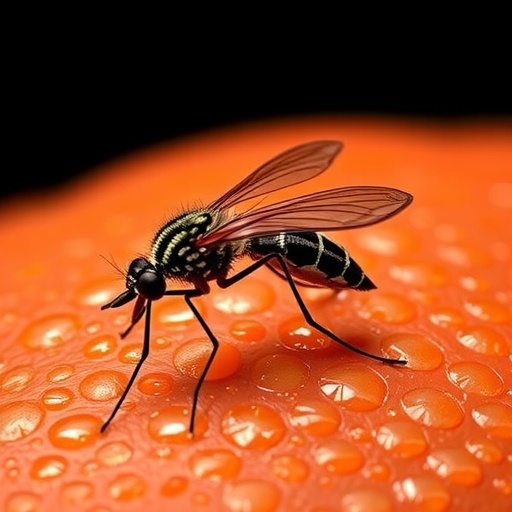The recent study serves as a compelling case for how interconnected health domains can provide early warning systems and actionable intelligence against emerging infectious threats. Traditionally, arboviral outbreaks have been studied through siloed lenses—focusing either on human clinical cases or entomological monitoring alone. However, the One Health approach dissolves these barriers, fusing insights from wildlife virology, vector ecology, climate factors, and molecular epidemiology. The researchers’ findings reveal that USUV and WNV are not only co-circulating within Dutch ecosystems but are demonstrating complex spatiotemporal patterns influenced by bird migration, mosquito population dynamics, and climatic fluctuations.
.adsslot_PmSMX8f4R0{width:728px !important;height:90px !important;}
@media(max-width:1199px){ .adsslot_PmSMX8f4R0{width:468px !important;height:60px !important;}
}
@media(max-width:767px){ .adsslot_PmSMX8f4R0{width:320px !important;height:50px !important;}
}
ADVERTISEMENT
Meteorological variables played a pivotal role in modulating vector competence and virus replication rates. Periods of warmer temperatures and extended drought conditions, observed concurrently with heightened mosquito abundance, created conducive environments for enhanced virus transmission cycles. These climate-driven ecological shifts underscore the increasing vulnerability of northern Europe to arboviral emergence as global temperatures rise and weather patterns become more erratic. By overlaying entomological data with regional climate models, researchers demonstrated predictive capabilities that could inform public health interventions and vector control strategies.
Molecular analyses revealed the presence of distinct viral clades corresponding to different introduction events and local evolutionary pressures. This genetic heterogeneity implicates multiple, recurrent introductions facilitated by migratory birds rather than singular establishment events, complicating eradication efforts. The recombination and mutation rates observed suggest that ongoing viral adaptation may shape future epidemic potential, necessitating continuous genomic surveillance. By monitoring these genomic shifts, the scientific community can remain vigilant against the emergence of more virulent or transmissible strains.
The collaborative framework adopted by the team transcended traditional disciplinary boundaries, uniting epidemiologists, virologists, entomologists, ornithologists, and climatologists. Such interdisciplinary cooperation enabled a comprehensive approach to understanding how human activity, biodiversity, and environmental change converge to influence viral dynamics. This paradigm exemplifies a model for tackling other zoonotic and vector-borne diseases with pandemic potential, emphasizing the value of integrative approaches in global health security.
Importantly, the investigation’s temporal scope allowed for the tracking of annual fluctuation in virus prevalence, highlighting periods of heightened risk corresponding with specific ecological and climatic triggers. This temporal mapping can empower local health authorities to optimize surveillance timing and resource allocation, thus enhancing early detection and prompt response. Moreover, the integration of veterinary health data furnished an early indicator of viral circulation before human cases emerged, underscoring the sentinel role of animal health monitoring in human disease prevention.
From a policy perspective, the findings urge the incorporation of One Health strategies into national and regional disease control frameworks. Given the transboundary nature of arboviral pathogens, coordination between neighboring countries and international agencies becomes indispensable. The study’s revelations about viral gene flow and ecological drivers can inform border health security, vector control policies, and wildlife conservation efforts, reflecting the interconnectedness of ecosystem health and human well-being.
On the technological front, the application of advanced molecular diagnostics and next-generation sequencing unlocked unprecedented detail about virus-host interactions and environmental reservoirs. Such technological sophistication empowers real-time monitoring and rapid response capabilities, critical in an era where emerging infectious diseases can spread swiftly across continents. The incorporation of digital data analytics and spatial mapping further enhanced the ability to visualize and predict outbreak patterns, offering valuable tools for epidemiological modeling.
Public awareness and education emerge as critical but oft-overlooked pillars of controlling emerging arboviruses. The study’s dissemination highlights the need for community engagement, especially in urban and peri-urban environments where human exposure to vector populations is significant. Emphasizing preventive measures—such as reducing stagnant water bodies breeding mosquitoes and promoting personal protection—can mitigate the risk of virus transmission to human populations.
The investigation also opens avenues for vaccine research and therapeutic development. Understanding strain diversity and genetic evolution provides vital clues for designing broadly protective interventions against flaviviruses. While no vaccines currently exist for USUV in humans, the study’s comprehensive data may catalyze efforts toward immunization strategies, particularly for high-risk groups in endemic areas.
As climate change continues to reshape the geographical boundaries of vector-borne diseases, this study serves as a harbinger of what may become a new norm in temperate regions. The northward advancement of vectors such as Culex mosquitoes and the accompanying viruses emphasize the urgency of establishing sustainable surveillance infrastructure, strengthening cross-sector collaborations, and investing in research capacity to preempt outbreaks.
In conclusion, the Dutch experience described in this landmark One Health study illuminates the multifaceted and dynamic nature of USUV and WNV emergence in Europe. Through rigorous integration of cross-disciplinary data streams, it crafts a sophisticated narrative of viral ecology shaped by complex biotic and abiotic forces. Such insights are imperative as the world grapples with the accelerating pace of zoonotic spillover events, underscoring the maxim that the health of people is inexorably tied to the health of animals and the environment.
Subject of Research: Emergence and dynamics of Usutu virus and West Nile virus in the Netherlands analyzed through a One Health approach.
Article Title: One Health approach uncovers emergence and dynamics of Usutu and West Nile viruses in the Netherlands.
Article References:
Münger, E., Atama, N.C., van Irsel, J. et al. One Health approach uncovers emergence and dynamics of Usutu and West Nile viruses in the Netherlands. Nat Commun 16, 7883 (2025). https://doi.org/10.1038/s41467-025-63122-w
Image Credits: AI Generated
Tags: arboviral outbreak surveillanceavian population healthclimate change and disease spreademerging infectious diseasesenvironmental impact on virusesinterdisciplinary health researchmosquito-borne diseasesOne Health frameworkUsutu virus dynamicsviral evolution in EuropeWest Nile virus transmissionwildlife virology and ecology





